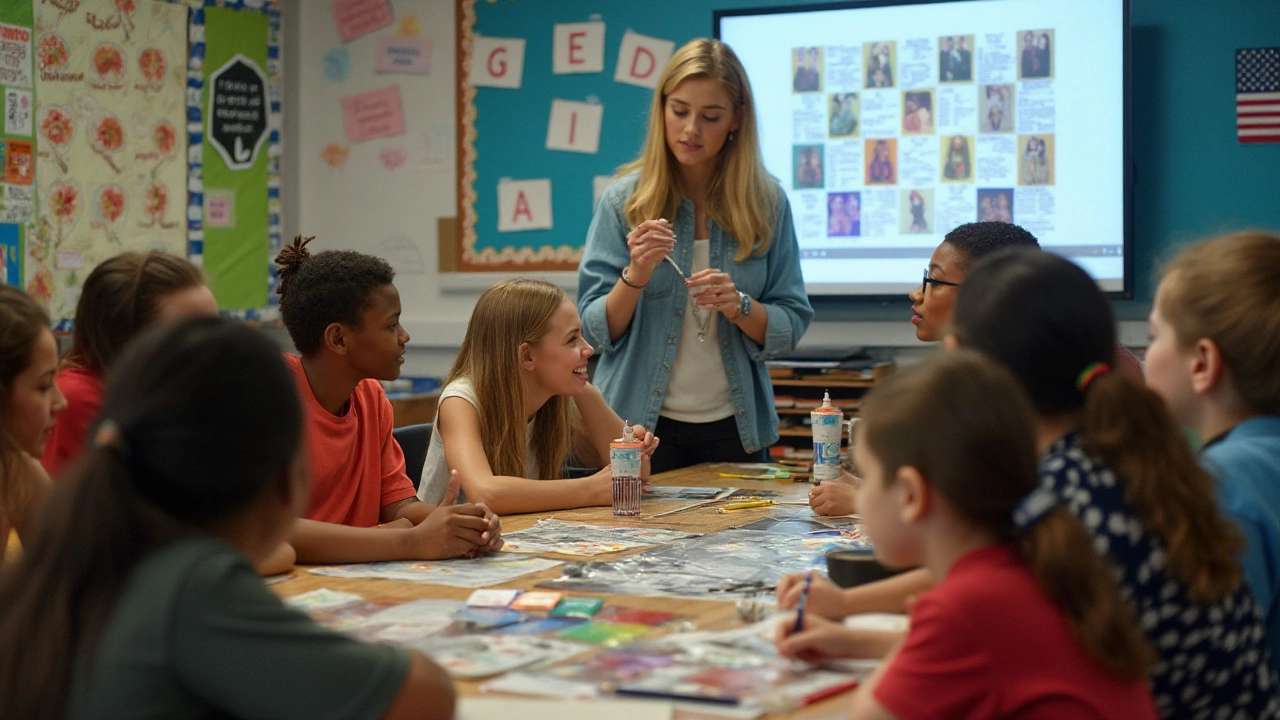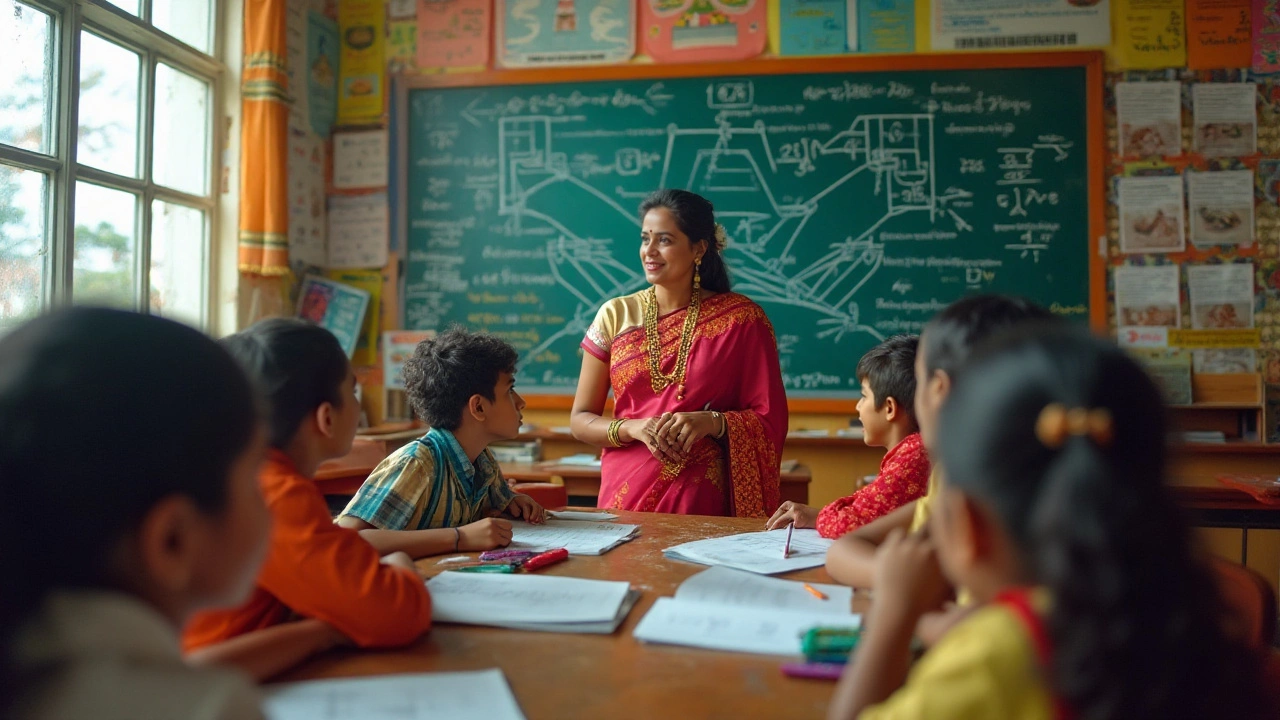Education is a vital part of a child's development, shaping their future and the world they will help build. When it comes to choosing the best educational pathway, parents and educators often find themselves comparing different systems.
Two countries that frequently come into the conversation are India and the USA. India is known for its strongly structured and rigorous CBSE syllabus, while the USA offers a diverse and flexible approach to education. Each system has its strengths, molded by the country's culture and societal needs, but understanding these differences can help students and parents make informed decisions.
In this exploration, we dive into what makes these two educational systems distinct, examining the intricacies of the CBSE curriculum and how each country applies its educational philosophies to learning and development.
- Introduction to Education Systems
- CBSE Syllabus Overview
- India's Educational Approach
- USA's Educational Style
- Comparative Analysis
- Conclusion on Effectiveness
Introduction to Education Systems
The global landscape of education is remarkably diverse, reflecting the unique cultural, economic, and historical contexts of different countries. In this detailed examination, we compare the education systems of India and the USA, two giants whose academic philosophies and practices shape millions of students' lives. Both nations prioritize education but adopt distinct methods to achieve their educational objectives.
India's education system boasts a rich historical legacy dating back thousands of years, with ancient universities like Nalanda. In modern times, the Central Board of Secondary Education (CBSE) stands as a pillar, offering a standardized curriculum across the country. The CBSE system emphasizes education, rigorous academics, and the study of sciences. It's renowned for its well-structured segmentation of subjects and clear guidelines. Indian schools often stress rote learning and memorization to instill a robust foundational knowledge in students.
“The roots of education are bitter, but the fruit is sweet.” - Aristotle
Conversely, the American education system emphasizes flexibility and liberal learning. It offers students numerous choices in subjects, promoting creativity alongside critical thinking. The USA’s approach is decentralized, with a core curricular framework allowing ample customization. This results in a more student-centered learning process, fostering a holistic development nurturing individual talents. Terms like 'critical thinking' and 'innovative problem solving' are at the core of the USA's educational approach.
Both systems reflect their societal values. India's emphasis on academics aligns with its competitive job market, which often values credentials and technical expertise. The USA, on the other hand, places a premium on innovation and entrepreneurial spirit, which its educational system mirrors through choice and flexibility. It's critical to realize that while both countries face their own sets of challenges, such as gaps in access and quality, they continue to evolve, striving for educational excellence.
In comparing these two systems, the crucial question often put forth is: Which system leads to better educational outcomes? The answer is multifaceted, intertwining the strengths and weaknesses inherent in each. A detailed comparative analysis is necessary, considering the depth, scope, and applicability of the CBSE syllabus outside India. So when making educational choices, understanding these foundational differences can be tremendously beneficial.
CBSE Syllabus Overview
The Central Board of Secondary Education, or CBSE, is a prestigious educational body that has been shaping the academic foundation for millions of students in India. Its syllabus is known for its comprehensive nature, designed to provide students with a deep understanding of subjects rather than a superficial overview. One might wonder what makes the CBSE syllabus stand out in the realm of education. Well, its strength lies in its continuity and consistency across various stages of schooling. From primary to high school, students are taken on a journey through structured educational milestones.
The CBSE curriculum emphasizes excellence in math and science, reflecting the global trend towards teaching STEM subjects. English and other languages are also given high regard, equipping students with strong communication skills. What distinguishes CBSE is the importance placed on board exams, which not only test rote memorization but also critical thinking and understanding. The emphasis on rigorous examination may seem daunting but it ensures that students are well-prepared for university education and competitive exams. According to a report from the National Council of Educational Research and Training, CBSE's continuous update of its content to align with changing educational needs is a pivotal feature that keeps it relevant. The syllabus is periodically revised to incorporate up-to-date knowledge and pedagogical approaches.
The National Education Policy 2020 put forth by the Government of India echoes this sentiment by stating, "The CBSE syllabus lays a strong foundation for all-round development catering to national and global needs."
An illustration of this is the inclusion of skill-based subjects, offering students the opportunity to choose electives based on their individual interests and career goals. From Information Technology to Fashion Studies, the elective options aim to equip students with skills beyond traditional academics. This flexibility in the curriculum is what makes CBSE adaptable and beneficial for students with diverse aspirations. Moreover, CBSE is unique in its integration of sports, arts, and physical education, ensuring that students receive a holistic education that goes beyond books and classrooms.
Moreover, assessments are designed to evaluate practical knowledge in addition to theory. This dual focus aids in nurturing analytical and problem-solving skills, essential for success in today's fast-paced world. The CBSE board not only prepares students for academic success but also cultivates essential life skills, making it incredibly popular among families striving for a balanced and thorough education. These advantages have contributed to its reputation as one of the most sought-after educational frameworks, both in India and abroad.

India's Educational Approach
India's education system is deeply rooted in its rich cultural heritage, where acquiring knowledge has been highly valued for centuries. The CBSE syllabus is a cornerstone of Indian education, recognized for its structured approach and focus on a robust understanding of fundamental subjects like mathematics, sciences, and humanities. Students are introduced to complex ideas and critical thinking early on, preparing them for competitive exams that hold significant weight in higher education admissions.
One of the most acknowledged aspects of the Indian approach is its depth and academic rigor. Students typically engage with core subjects, ensuring they build a strong foundation before specializing. This is particularly reflected in subjects like mathematics, where problem-solving skills are honed extensively. However, this intense focus on academics can often overlook creative and physical development. As renowned educationist Amartya Sen once highlighted, "Education in India is heavily exam-oriented. There lies both its strength and challenge."
Education in India is not merely confined to textbooks. The integration of traditional values and modern technological advancements has created a dynamic platform for learning. Schools are increasingly incorporating digital tools and smart classrooms to make learning experiences more interactive. Extracurricular activities, although secondary to academics, are gaining attention as schools recognize their role in developing well-rounded individuals. There is a growing movement towards balancing the traditional academic focus with opportunities for creative exploration.
While the merits of a rigorous academic syllabus cannot be understated, the stress associated with competitive exams often impacts students’ mental health. The pressure to excel can be overwhelming, but gradually, more emphasis is being placed on counseling and psychological support within schools. This recognition is vital for ensuring that education remains a supportive and enriching journey for all students. With the advent of the National Education Policy (NEP) 2020, India is aiming to transform its education model, prioritizing critical thinking, creativity, and life skills.
The cultural aspect of Indian education is another fascinating dimension. Schools often celebrate festivals, incorporating music, dance, and art into the curriculum, providing a holistic development platform. This blend of culture with academia effectively instills patriotism and social responsibility among students. Diet diversity also finds its place in Indian schools with regional cuisines often part of daily meals in many institutions, promoting healthy eating habits. This cultural integration is not only about recognizing heritage but also about fostering unity in a diverse nation.
In summary, India's educational approach, particularly through the CBSE syllabus, emphasizes academic rigor and structured learning. While there's room for improvement, particularly in nurturing creativity and emotional intelligence, the system's focus on core subjects has indisputably created generations of academically proficient individuals. With new reforms in place, there is hope that the Indian education system will evolve to equally prioritize both intellectual and personal growth.
USA's Educational Style
The educational landscape in the USA is characterized by diversity, flexibility, and a broad spectrum of opportunities that cater to varied learning needs. This system is often lauded for emphasizing individual growth and critical thinking as opposed to rote memorization. In American classrooms, there is a pronounced focus on nurturing creativity and problem-solving skills, which are seen as crucial components of preparing students for a rapidly changing world. Teachers in the USA often encourage students to participate in discussions and express their viewpoints, fostering an environment of open communication. This helps students develop a sense of confidence and curiosity, essential traits for lifelong learners.
One of the standout features of the American educational system is its adaptability and readiness to integrate innovative teaching methodologies. Schools often incorporate project-based learning, which allows students to work on real-world problems and apply theoretical knowledge in practical scenarios. The incorporation of technology in classrooms is also exemplary, with digital tools and resources being widely used to enhance learning experiences. According to data from the National Center for Education Statistics, 94% of public school districts reported that they provided students with digital devices, showing a commitment to bridging the digital divide and ensuring all students have access to modern learning tools.
Another critical aspect of the USA's educational approach is its inclusivity and respect for diverse backgrounds. Schools aim to accommodate students from varied cultural, linguistic, and ability spectrums. The Individuals with Disabilities Education Act (IDEA) is a landmark legislation that ensures students with disabilities have the same opportunities for education as those without. Educators are trained to employ differentiated instruction techniques, adjusting their teaching strategies to meet each student's unique learning style. This adaptability not only aids in academic success but also prepares students to thrive in a globalized society.
"Education is the most powerful weapon which you can use to change the world." - Nelson Mandela
The school structure itself is quite distinct from those found in other countries. With a decentralized system where local governments hold significant power in making educational decisions, schools have the autonomy to design curricula that reflect local values and needs. This often results in a wide array of subjects and extracurricular activities, ranging from arts and humanities to advanced sciences and technologies. It allows students to explore their interests deeply and can guide them in making informed decisions about their future careers.
Recent trends in American classrooms also indicate a shift towards a more holistic educational model. Emphasis is placed not only on academic accomplishment but also on developing emotional and social intelligence. Programs that focus on mindfulness, social responsibility, and community service are increasingly integrated into school curriculums. The aim is to produce well-rounded individuals who can contribute positively to society. School reports from the National School Boards Association highlight that 73% of public schools in the USA offer students opportunities to engage in voluntary community service, highlighting the importance placed on community engagement and responsibility.
The ethos of the American education system underscores the idea that learning extends beyond the classroom. Field trips, internships, and exchange programs are important parts of the curriculum, providing students with the opportunity to gain real-world experiences and broaden their horizons. This experiential learning approach helps reinforce classroom teachings and allows students to see the direct impact of their education on the world at large.

Comparative Analysis
When analyzing the educational systems of India and the USA, especially through the lens of the CBSE syllabus, several key differences stand out prominently. In India, education is steeped in discipline and a structured curriculum that focuses heavily on theoretical knowledge, primarily concentrating on mathematics and sciences, particularly from secondary education onward. The CBSE framework is designed to prepare students for rigorous competitive exams crucial for entrance into higher education. Indian schools often dedicate extended hours and higher student-teacher ratios, emphasizing memorization and rote learning, aiming to ensure students excel in standardized examinations.
Conversely, the educational landscape in the USA exhibits a broader curriculum encouraging a more exploratory and flexible learning model. American schools emphasize critical thinking and creativity alongside traditional academic subjects. The diversity in subjects offered includes arts, sports, and vocational skills, promoting a well-rounded skill set in students. Teachers in the USA often encourage interactive sessions and project-based learning to foster a deeper understanding of concepts, which can sometimes prove beneficial over memorization.
Another distinct contrast is the emphasis on extracurricular activities within the US school system. While Indian schools are increasingly recognizing the importance of such activities, American schools have a longstanding tradition of nurturing talents beyond academics. Students in US schools have opportunities to engage in a wide variety of clubs, sports, and arts, helping them develop leadership and teamwork skills early on. These extracurricular pursuits sometimes have significant weight in college admissions, making them an integral part of the educational journey.
"Education is not the filling of a pail, but the lighting of a fire," said W.B. Yeats, a sentiment that resonates deeply with the American educational philosophy which aims to ignite curiosity and independent thinking in students.
The societal perceptions and pressures also vary markedly between the two countries. In India, there is often immense stress placed on achieving high academic scores as a gateway to professional success. This focus can sometimes limit innovation and discourage students from pursuing unconventional career paths. On the other hand, the societal environment in the USA generally supports diverse career choices, allowing students to select paths aligned with their personal interests and strengths.
There has been a shifting tide in both countries to imbibe select practices from each other. Indian educational institutions are increasingly incorporating hands-on learning and interactive sessions, seeking to move beyond rigid exam-centric models. Meanwhile, certain US schools are adopting structured programs like STEM (Science, Technology, Engineering, and Mathematics) to mirror the focus seen in the CBSE syllabus.
In evaluating the effectiveness of education in India versus the USA, it becomes clear that each offers unique advantages shaped by their cultural, economic, and societal frameworks. Families seeking a pathway that balances academics with personal development will find aspects from both educational systems valuable, leading to enriched learning experiences tailored to their aspirations. As education continues to evolve globally, the amalgamation of both approaches may very well pave the way for future educational models, merging depth with breadth to benefit student development worldwide.
Conclusion on Effectiveness
Determining whether the education system in India or the USA is more effective is a complex task, as each has its own set of strengths and challenges tailored to their cultural and societal values. The CBSE syllabus in India is heralded for its emphasis on in-depth theoretical knowledge and structured learning path. This method ensures that students often excel in fields that require strong foundational knowledge, such as engineering and medicine. With a formidable reputation for rigorous academic standards, India's approach nurtures disciplined study habits early on and fosters a deep understanding of subjects.
Conversely, the USA's education system is widely appreciated for its emphasis on creativity, critical thinking, and versatility. It fosters a learning environment where students are encouraged to explore a wide range of disciplines, thus nurturing well-rounded individuals. This approach tends to produce adaptable thinkers who are prepared to tackle an ever-evolving global job market. It is not uncommon in American schools to see a mix of academic and extracurricular pursuits, creating a more holistic educational experience.
Interestingly, both systems have been critiqued for their limitations. While India's CBSE could benefit from more emphasis on creativity and critical thinking, the USA's system sometimes lacks foundational depth that is purely knowledge-based, particularly in the early high school years. A notable fact is that students from each system perform impressively on international platforms, indicating that both approaches are capable of producing successful individuals when executed with commitment and skill.
The OECD's Programme for International Student Assessment (PISA) found that a mixture of foundational knowledge and creativity is crucial for fostering competent individuals ready for the challenges of the 21st century. Yet, both India and the USA show varying degrees of this blend.
Each country stands at a crossroads, where incorporating elements from the other's system could potentially enhance their educational outcomes significantly. Indian schools could implement more creative and critical thinking opportunities, while American schools might benefit from incorporating more formally structured learning modules that ensure strong foundational knowledge. Both these systems continue to evolve, learning from global trends to better prepare their students for the future. The choice between India's CBSE syllabus and the American educational style ultimately depends on the individual needs and aspirations of students and their families. Thus, a nuanced understanding of each system's strengths is imperative to make an informed decision.






Write a comment: